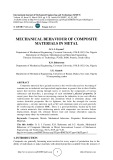
http://www.iaeme.com/IJMET/index.asp 9 editor@iaeme.com
International Journal of Mechanical Engineering and Technology (IJMET)
Volume 10, Issue 03, March 2019, pp. 9-20. Article ID: IJMET_10_03_002
Available online at http://www.iaeme.com/ijmet/issues.asp?JType=IJMET&VType=10&IType=3
ISSN Print: 0976-6340 and ISSN Online: 0976-6359
© IAEME Publication Scopus Indexed
MECHANICAL BEHAVIOUR OF COMPOSITE
MATERIALS IN METAL
O. S. I. Fayomi*
Department of Mechanical Engineering, Covenant University, P.M.B 1023, Ota, Nigeria
Department of Chemical, Metallurgical and Materials Engineering,
Tshwane University of Technology, P.M.B. X680, Pretoria, South Africa
K.O. Babaremu
Department of Mechanical Engineering, Covenant University, P.M.B 1023, Ota, Nigeria
I.G. Akande
Department of Mechanical Engineering, University of Ibadan, Ibadan, Oyo state, Nigeria
*Corresponding author
ABSTRACT
Composite materials have gained traction in the world today and are becoming of
common use in industrial and specialized applications in general due to their flexible
nature that involves mixing through layers or matrixes the components of various
substances and therefore, a percentage of each substance’s physical properties. In
recent years there has been an increasing concern for industries to use cost effective
reinforcement for metal materials like aluminum which is abundant cheap, with
various desirable properties like its lightness, but lacks the strength for various
applications – ceramic materials such as SiC and aluminum oxide are used generally
for reinforcing the aluminum MMC. There is a good probability, backed up by tests
for certain materials, that reinforcing metals with composites can increase failure
displacement, fatigue life, ultimate failure load and energy absorption capacity,
amongst many others by substantial amounts.
Keywords: Composite, Metals, Mechanical behaviors, Properties, Reinforcement,
Materials.
Cite this Article: O. S. I. Fayomi, K.O. Babaremu and I.G. Akande, Mechanical
Behaviour of Composite Materials in Metal, International Journal of Mechanical
Engineering and Technology, 10(3), 2019, pp. 9-20.
http://www.iaeme.com/IJMET/issues.asp?JType=IJMET&VType=10&IType=3
1. INTRODUCTION
Composite are generally becoming more involved in every aspect of production due to the
ability of individuals to make materials with desired properties available from the mixture of





















